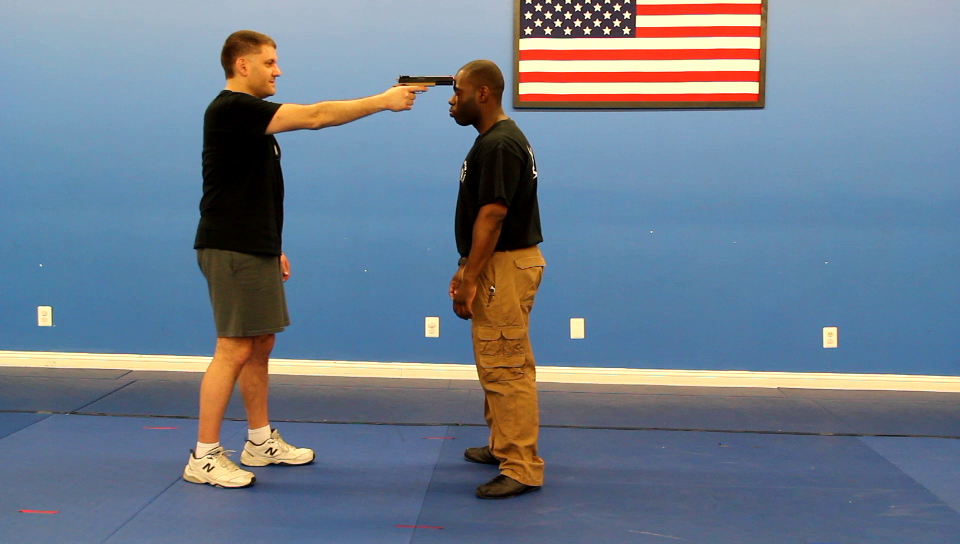What you see above is your humble blog writer pointing a practice handgun at the head of his karate and Krav Maga instructor, Clifton Abercrombie of Super Kicks (web, Facebook) in Forest, Virginia. My instructor is about to demonstrate a Krav Maga technique for defending oneself against an assailant who points a gun right at the head of a would-be crime victim. Krav Maga means "contact combat" in Hebrew and is an Israeli martial arts system that is essentially an amalgam of the best techniques from various other martial arts systems.
Does what you see above look a bit scary? I'm certainly not crazy about seeing a gun pointed at anyone's head. Using practice weapons in a safe environment, I train with several others in Krav Maga, and part of our training involves escaping the frightening situation mimicked in the photo above. I frankly have no idea how well I would do if ever unfortunate enough to find myself with a loaded gun pointed at my head. I hope that training will give me an automatic response so that I'll at least be able to fight back.
What I wish to focus on here is the physics behind what Mr Abercrombie is about to do next. His main goal is to get the gun's barrel out of line with his head -- and do it quickly! What about moving his entire body to the side? Too much mass! It will take too long. He will move his arms, which are much less massive than his whole body. The best athletes have been measured to have a reaction time of not less than about 0.2 s. During those measurements, however, athletes knew what was coming and how they were to react. For most us in a car, we have a reaction time of at least a full second. The study of human reaction time involves neurophysiology, biomechanics, and a host of other goodies. First the eye (or some other sense organ) detects something, then the brain processes a signal, and then the brain tells the body to do something. That's obviously highly simplistic, but if an attacker with a gun isn't expecting resistance, assuming the attacker's reaction time to be a full second isn't likely to be that far off. Note that I use reaction time to mean the time between Mr Abercrombie initiating his defense, which may be imperceptible to me if I'm staring at his face and perhaps yelling at him, to the time when I fire the gun in response to my brain finally processing that he is fighting back and getting a signal to my hand to fire.
Let's now turn to the defense. Check out the sequence of photos below (click on the image for a larger view).
It took Mr Abercrombie just 0.8 s from the first wiggle his hand made that showed he was initiating a defense to getting his hands on the gun, as shown on the left. If you think a reaction time of a full second is too large and that a safety factor is needed, cut that reaction time in half. I would not have distinguished his initial hand movements from normal motion. The first half of that 0.8 s probably passed before I even noticed that he was trying to defend himself. So if I'm able to react from that in half a second, he still has his hands on the gun before I can fire. The photo on the right shows that his head is out of the gun barrel's firing line. The time between left photo and right photo is just 0.03 s. Even if I can get a shot off, it will sail over his head.
Note in the very first photo above that I kept my finger off the trigger and along the side of the gun. While practicing, that's very important! Watch what happens next (click on the image for a larger view).
Mr Abercrombie rotated my hand and gun clockwise (as seen by him) and away from him toward his right. He kept rotating such that if my finger were on the trigger, he would have used enough torque to have broken it! That's part of the technique. Distract the assailant with something to think about (like pain from a broken finger!) while the tables get turned. I am officially disarmed in the photo on the left, and that took Mr Abercrombie just 0.16 s after he had the gun's barrel clear of his head. The image on the right is 0.1 s after the left image. Note that Mr Abercrombie not only has control of the gun with the barrel pointed away from him and toward me, he still maintains control of my hand. That's important because a real attacker is likely to be fighting back at this point.
Now we get to the end and I, as the dumbfounded faux attacker, have realized that I messed with the wrong man! Click on the image below for a larger view.
Just 0.16 s after the previous image, Mr Abercrombie released my hand. He then cleared away and secured the gun to his side. I'm left with an open hand! The entire technique from the first image I showed above with Mr Abercrombie beginning to move his hands to the final image on the right took just under 2 s. That was all the time needed for my Krav Maga instructor to react to having a gun at his head to holding the gun himself while at a safe distance from me. Not bad, huh?
To see the technique play out in real time, check out the movie below.
There are a couple of seconds of set up time, followed by the disarming technique in action. Mr Abercrombie makes it look simple, but a LOT of training is required to be that good!





No comments:
Post a Comment